Starlings: Mapping and modelling the ballet of the skies
- Published
The beautiful, baffling seasonal spectacular is back for another year: starlings, swirling in their hundreds and thousands, in shapes that defy mathematical description.
How on earth do they co-ordinate these aerobatic displays, and what purpose do they serve?
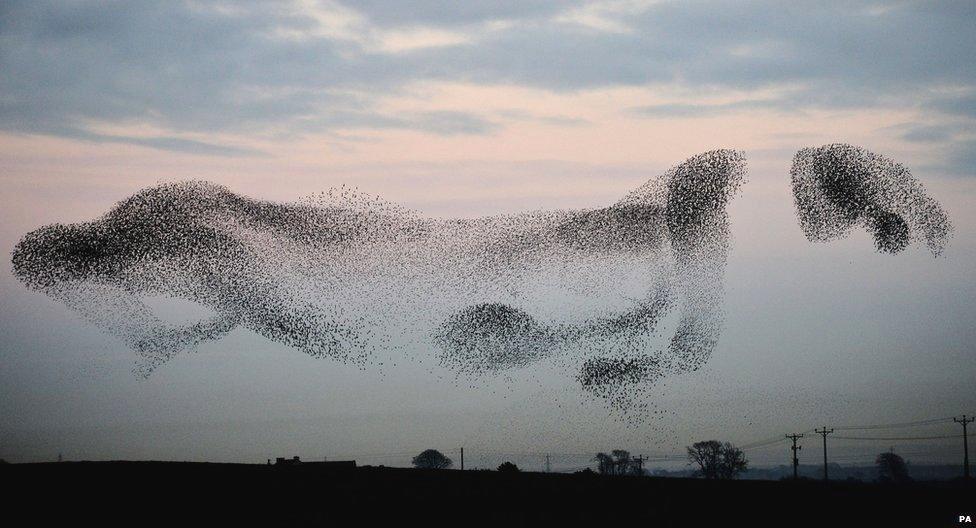
Starling murmurations can be seen every year in the UK, from around October to February
These questions mystify scientists just as much as passers-by. The "murmurations" of starlings, now in season for 2014, are a hot topic of research.
While some try to explain the formations using 3D mathematical models, other researchers are calling on the public for help.
"It's the first time that this approach has been possible, to look at lots of different sites all over the country, over a sustained period," said Dr Anne Goodenough, an ornithologist at the University of Gloucestershire.
A murmuration map
Dr Goodenough and her colleagues have launched a Starling Survey, external, in collaboration with the Society of Biology.
They are asking members of the public to report murmurations using an online form. It has been running for one week, and results have already started to flow.
"We've got about 60 records so far," Dr Goodenough told the BBC. "Given that it's still early in the season, we're really pleased."
When they witness a murmuration, citizen scientists can visit the page and answer a few short questions, such as where and when it took place, how long it lasted, and how many birds were involved.
Counting could prove a challenge, however: starlings have been known to flock in their thousands or even millions. Dr Goodenough said she just wants participants' best guess, no matter how tentative the speculation.
"It's a strong use of the word 'estimate'," she said.
Part of the power of the survey will be repeated observations. "We're encouraging people, if they happen to see a murmuration regularly, to give us those regular sightings rather than thinking that particular flock has been accounted for," Dr Goodenough explained.
"We're interested in each and every murmuration event."
Using all of this data, the project will build up a map of how murmurations of various sizes are distributed around the country. This is exciting, Dr Goodenough explained, because it casts the net much wider than known hotspots, like Brighton's West Pier and Gretna Green near the Scottish border.
"There must he hundreds if not thousands of smaller sites that we just don't know about," Dr Goodenough said.
The 60 or so sightings already logged stretch from Scotland to the south coast, via Aberystwyth.
"We've already got a very big geographical distribution - and interestingly, none of the absolute hotspots have yet shown up in the data."
Hunting patterns
As well as mapping when and where they happen, the team wants to explore why this aerial ballet takes place.
One long-standing but unproven idea is that the dramatic, rippling shapes help save the starlings from bigger birds trying to eat them.
Bird flocks generally offer safety in numbers, but the starlings' distinctive formation flying might mesmerise and distract a hungry falcon, for example.
"It might be difficult for an aerial predator to focus on one bird and go after it," Dr Goodenough explained.
Alternatively, they might be keeping warm. "There's a thermal benefit to roosting as one of a big flock, instead of on your own or in a small flock."
So as well as time, location and numbers, the survey asks for a few other details: the weather conditions, the type of environment, and whether any predators were spotted.

Brighton's derelict West Pier is a well-known murmuration site
Collecting this information across the country and throughout the season will allow the researchers to look for patterns. Are the flocks bigger when the air is nippy? Do the murmurations last longer when there is an owl on the prowl?
"You can only weed those kind of subtleties out of a large data set," Dr Goodenough said. "That's the sort of information that we don't have at the moment, and it's why this study is so important."
Although still a common species, the starling population in the UK is estimated to be less than a quarter of what it was 50 years ago. Dr Goodenough emphasised that the survey is not investigating the decline specifically, but its findings will certainly be useful for conservation efforts.
Cryptic choreography
While citizen science is chipping away at the 'where', 'when' and 'why', the question of 'how' remains up for grabs.
Even using computer models, physicists and mathematicians have struggled to explain the synchronised, rapidly fluctuating movements of starling flocks.
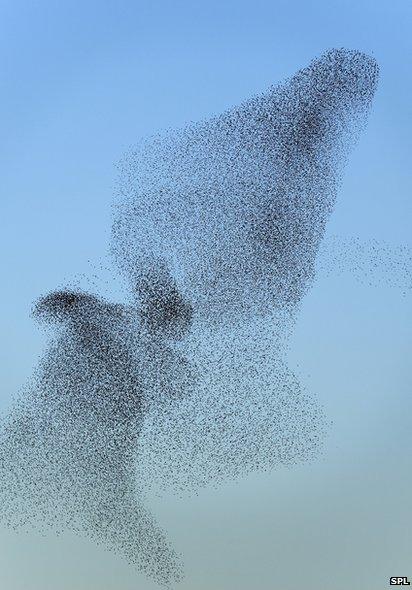
Each starling chooses its direction based on six or seven neighbours
One breakthrough came in 2008 from researchers at the Centre for Statistical Mechanics and Complexity in Rome - a city famously overrun by millions of starlings every winter.
A team specialising in collective behaviour filmed murmurations of up to 2,700 starlings above the National Museum, from multiple angles, and built 3D reconstructions.
Analysing those 3D movies produced several new discoveries, external. For example, the birds tended to be closer to their neighbours on either side, rather than in front or behind - which makes sense for avoiding mid-air, rear-end collisions.
Individual starlings rotated through different positions in the flock, and the groups were packed more tightly in the middle.
Most interestingly, every bird copied its direction only from its closest six or seven neighbours, no matter how closely packed they were.
"That's quite unique in science - that's a really unusual kind of interaction," explained Prof Matthew Turner, a physicist at the University of Warwick who also studies flocking behaviour.
Prof Turner has put that finding into his own flocking model. Instead of recording the birds' behaviour and teasing it apart, he is trying to copy it using mathematical rules.
"This is an amazing thing that these birds are doing," he told BBC News. "If you were programming them, how would you get them to do it?"
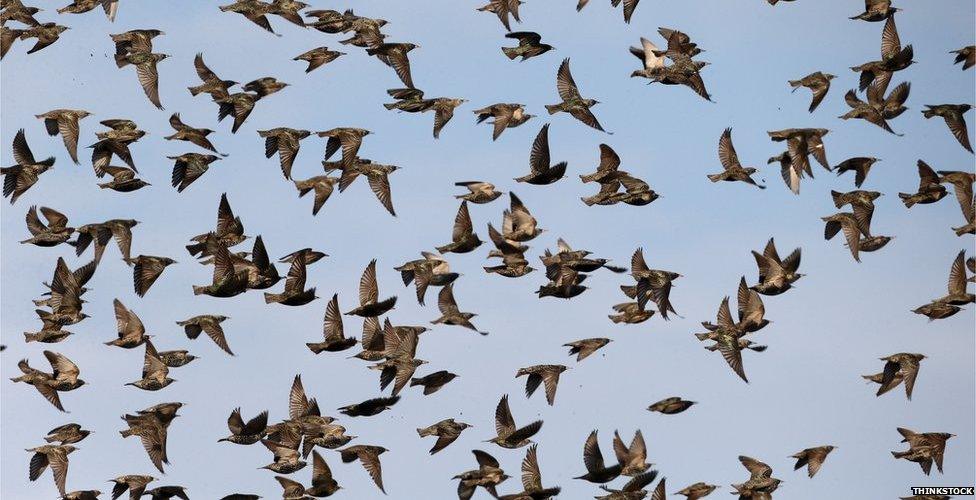
The density of the flock is a key question for scientists building models
In his computer model, Prof Turner created a flock of simplified birds in 3D space, and calculated what they could "see".
This is unlike other interactions that physicists study, he explained.
"These things aren't atoms. The only thing they've really got to drive this interaction is their vision. So we thought, what are they seeing?"
Living on the edge
Each bird in the model is presented with a different pattern of black (other birds) and white (sky). It aligns itself with the closest few neighbours it can see, as suggested by the Italian study.
But then what?
Prof Turner and his team looked for the simplest set of rules that would produce something like what starlings do over Rome and Brighton.
They found that if the birds were simply programmed to fly towards the darkest areas, they collapsed onto a single point. If that was reversed, the flock dispersed and vanished.
But if the birds sought out the boundaries between black and white - heading for the edges - then over time, they stuck together as a flock: not too close together, and not too far apart.
Based on a set of mathematical rules, the Warwick team’s model has begun to reproduce flock-like movement
"It turned out to be this very special density where you can just about see through the flock," Prof Turner explained. The birds can still see out to the sky, but they have safety in numbers.
"It's exactly the density, we think, that balances protection with information."
So it models a flock - but does the model "murmurate"? It is quite hard to know, according to Prof Turner.
"It's actually quite difficult to put your finger on what this coherent motion is, that we as humans naturally recognise.
"That's still not really been properly mathematically described. So it's difficult to know what we're aiming for."
His model, he thinks, gets closer than others because the birds can see across the flock, which would help with co-ordinating twists and turns. But there remains "a lot to figure out".
Meanwhile, Prof Turner welcomes the Starling Survey's effort to tackle other questions - notably, why murmurations happen.
"I think that's going to be fascinating," he said. "It will go a long way towards answering that 'why' question."
The mystery of murmurations, it appears, will only be unravelled by one complicated strand at a time.
Follow Jonathan on Twitter, external
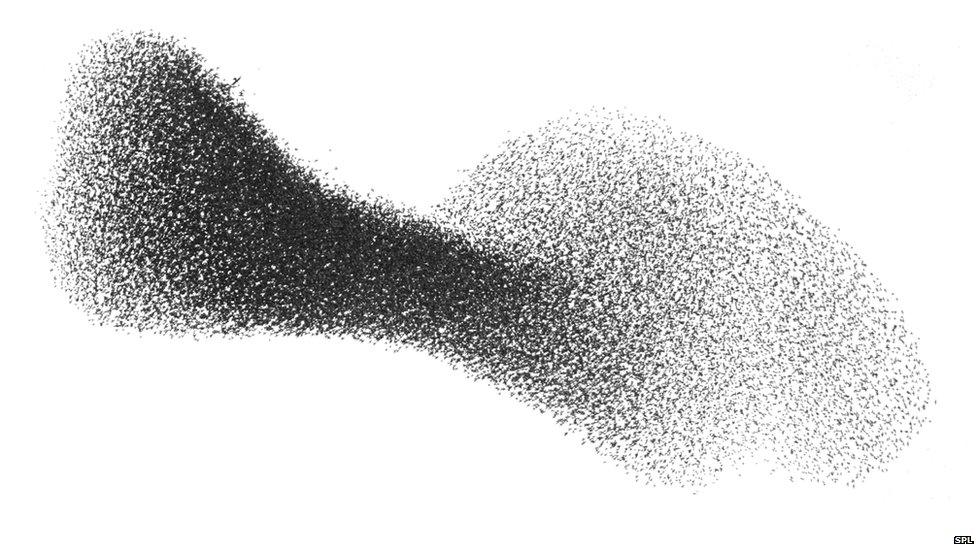
The mathematical rules behind mesmerising formations like this one, photographed in Rome, are baffling
- Published26 February 2014
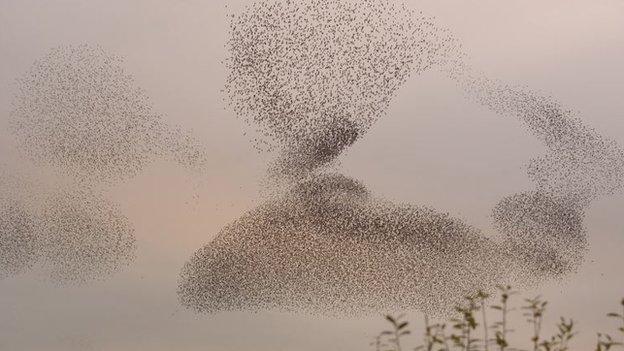
- Published3 April 2013
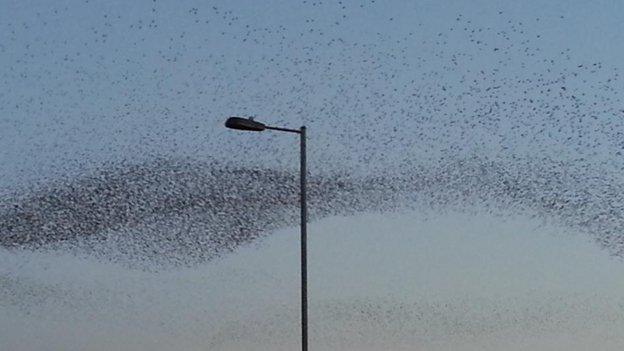
- Published14 November 2010